View current page
...more recent posts
"Slow Hooterville" [mp3 removed]
For Sidstation and analog drum synthesizer; additional percussion: Linplug RMIV.
A few months back I asked some questions* about how "tracker music" differed from early breakbeat hardcore and sequencer-based music generally, and I've still been somewhat confused. This post by Marius Watz, which Marisa Olson recently reblogged on Rhizome**, helped me quite a bit.
The arcane art of tracking takes what I like to think of as a hackerís approach to making music. The interface is primarily numeric, notes are entered via the keyboard, length, parameters, effects are often entered in hexadecimal notation, and code flies across the screen as if you were looking at the opening credits of The Matrix. Whatís not to like?*My questions from last April were: "I'm still curious (and googling) about the interrelationship of the Atari demoscene, amigatrackers, and early rave and 'ardkore. How much was hobbyist/cultist vs real club/dancefloor breakthroughs? Also how much was actually hacked and/or open source vs just using the products companies were selling? Then or now? From the wiki article it sounds like the Akai and the tracker software were inseparable 50/50 partners in defining the 'tracker' sound. Is that the same thing as 'classic' breakbeat rave or breakbeat techno? The article makes 'tracker' music sound like a cheesy variant--did that happen later or was tracker music always the music of hobbyists/Atari cultists? Finally, is the 'tracker scene' mainly a European thing?"
Kuro5hin has a good article and how-to on cutting up breakbeats with tracking. It lists possible software (such as Renoise) and gives a step-by-step breakdown of how to go about murdering the Amen Break (the biggest drumíníbass break of all timeÖ) For more insights into the origin of tracking culture, Salon.com has an article [from 1999 -ed] called MOD Love.
The Salon.com article points out that the analogy that tracking is to music what code is to software is a bit of an overstatement. Tracking, which involves writing notes and effects in hexadecimal code, is still much like sequencing. Its true significance seems to stem from the fact that tracking started as a DIY culture, by kids who had no access to professional equipment (and frequently, no musical training). But tracking also allows a mechanical approach to music that makes it attractive to practitioners of drumíníbass, breakcore, digital hardcore or plain old noise.
I've concluded that the scenes were completely separate in the late 80s/early 90s: tracking was the domain of hackers making mostly chiptunes or cheesy rave tracks, while Rob Playford, A Guy Called Gerald and other mainstays of early breakbeat and jungle were using primordial versions of programs like Logic, hardware sequencers, and more pricy (?) samplers. What's happened in the last few years is a late merger of the two styles, with trackers being used to trigger samples in very fast "jungle-like" music. In the earlier thread we had some miscommunication but I think I'm clear on this now.
**Update, 2011: The Rhizome link has been changed to http://rhizome.org/editorial/2005/nov/26/the-arcane-art-of-tracking-vs-the-amen-break/
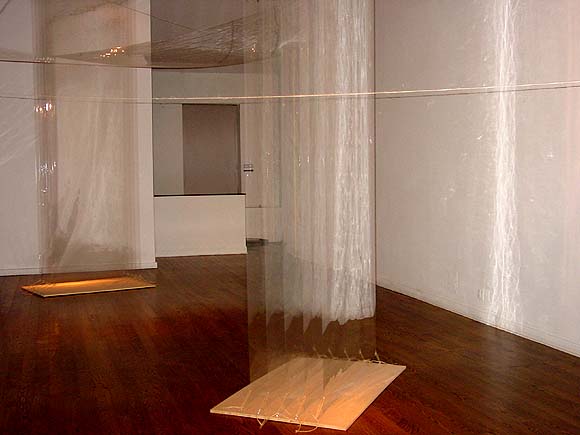
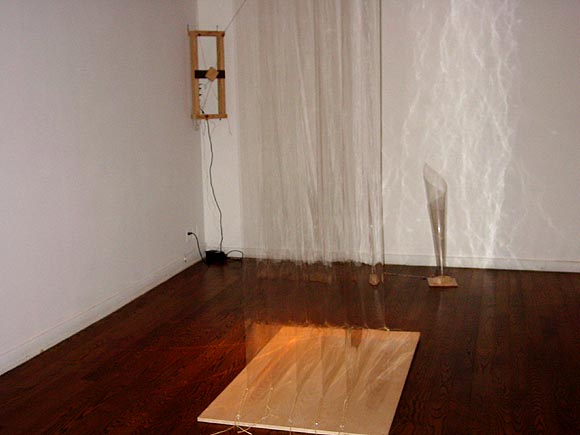
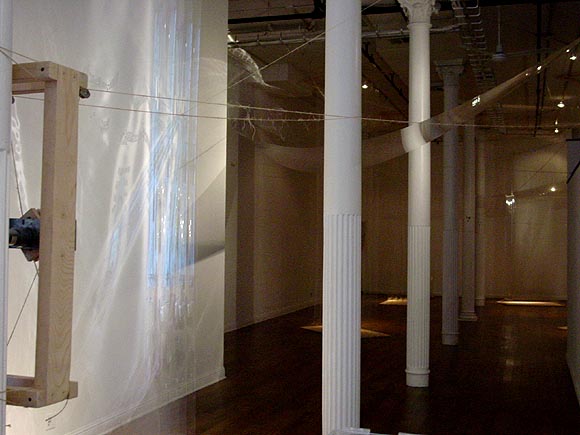
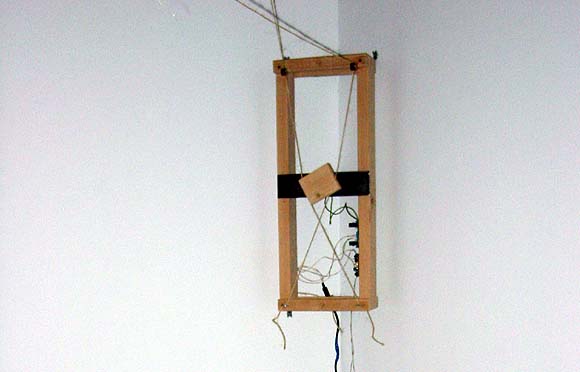
My photos from Douglas Irving Repetto's show at Location One, 26 Greene St., NYC; the exhibit will be open one more day (tomorrow, Saturday, November 26). Microphones at the bases of mylar cones pick up room sounds, which trigger sensors causing the wooden cams to turn, making twine move on pulleys stretched across the room (think Fred Sandback meets Cronenberg's Spider), which in turn jiggle vertical sheets of mylar, making abstract reflections on the wall shimmer ever so slightly. As the press release describes it, "the piece 'breathes' in sympathy with the ambient sounds in the gallery, rippling and reflecting light when there is a sound and resting, invisible, when there is silence. Because of the transparency of the mylar strips, the effect is subtle and eerie, a gossamer membrane that functions as acoustic barometer, making visible sonic phenomena that are often heard, but rarely seen." The effect is not as dramatic as we're used to in this age of pyrotechnic insanitaria, but I believe that's the point.
Repetto's site documenting the piece is here.
"Suite 6" [mp3 removed]
No. 7 in the Sidstation/analog drum machine series. I'm especially happy with the drumming on this one.
Nos. 1-6 are here. I continue to mess with them, so they gel as a series, with similar volume levels, "dry" sounds as opposed to special-effected, etc. I cheated a bit to get the number to 7 by including both versions of "Protest Song." But no one says I have to stop at 10; I can always do more and edit. But I'm already itching to start polluting these with more softsynths and virtual percussion.
Happy Thanksgiving. Please be sure to read Sidney Blumenthal's Salon essay on Dick Cheney's climb to power. It tracks this warped creature from his palace coup (with Rumsfeld) kicking the moderates out of the Ford administration, to acting as point man for the Iran Contra traitors during his years in Congress, to engineering Gulf War I (supposedly the "good war" but as bogus as the current one IMHO), to picking himself for Bush Jr.'s VP, to his big moment--the opportunity to put all his world-dominating plans into action: 9/11. One of the most noteworthy things to me is that, yes, Cheney is a man of ruthless ambition, a bureaucratic inside player, and all that, but he's also largely incompetent. He completely had the Soviet threat wrong, right up until the USSR collapsed, and he consistently overstated Iraq's threat to the Middle East in both wars he got us into. Vice President for Torture--already planning his retirement to Eastern Maryland, where he will live off his stolen taxpayer money until his ticker finally gives out. Here's hoping he gets some Pinochet action, late in life, when he's all ready to relax. And here's hoping history properly places him on the dark side of America, along with Joseph McCarthy and the Boston Strangler.
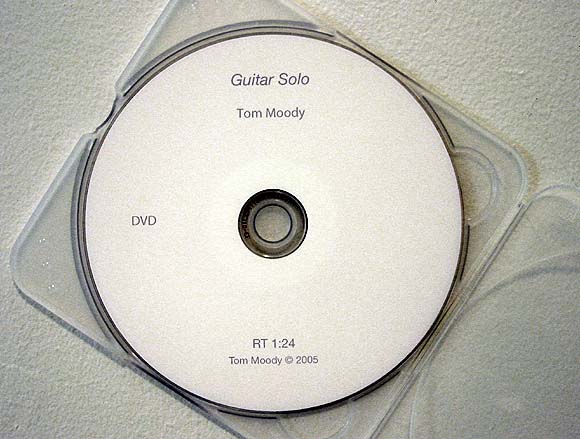
Going back through my email, realized I forgot to plug the second appearance of the Nick Hallett-curated video program 23 REASONS TO SPARE NEW YORK. D'oh, it was last Friday and Saturday, Nov. 18 and 19, at MONKEYTOWN, Williamsburg's premiere video eatery. "23 Reasons" is a reel of music videos Hallett put together of experimental rock tunes, all by local bands, featuring Animal Collective, Antony & the Johnsons, Black Dice, Grizzly Bear, Jason Forrest, Liars, and others, and includes my web video "Guitar Solo" (tastefully memorialized in DVD form above--nice wall texture, huh?).
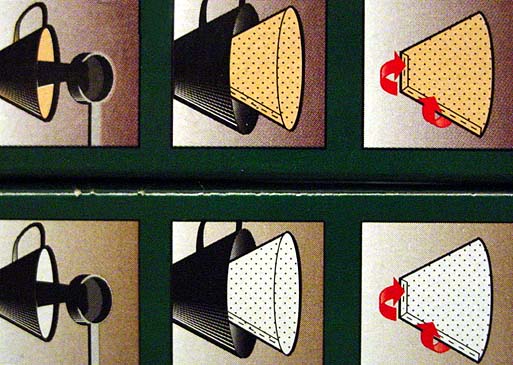
From the Seattle Post-Intelligencer:
But [Montana] governor [Brian Schweitzer] is no fan of the Democratic Leadership Council -- the centrist outfit, once headed by an ambitious Arkansas governor named Bill Clinton, that is populated by Washington, D.C., lobbyists and funded by their corporate overlords.I suppose we could feel the same way about any "cultural elite." Hollywood in LA, Madison Avenue in NY. But of those elites, only the one in DC has the power to appropriate our money and kill untold numbers of people. I share Schweitzer's frustration, watching powerless from afar this grotesque DC culture where rich lobbyists mingle with rich, big hair news media and rich helmet haired Congressmen at parties. You want to knock all their heads together and say: "You're a bunch of effete screwups!" It hurts instead to have to watch them all "get on the same page," and "get behind" the Iraq debacle, the Bush tax cuts, the anti-bankruptcy bill and other horrors.
"Washington, D.C., is a giant cesspool filled with special interests," Schweitzer said. "Unless we change the culture of Washington, D.C., we're not going to change the country."
